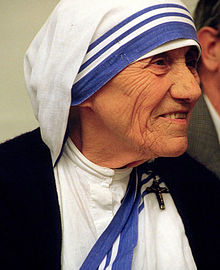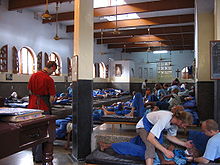- Missionaries of Charity
-
 Mother Teresa, founder of the Missionaries of Charity.
Mother Teresa, founder of the Missionaries of Charity.
 Missionaries of charity with the traditional sari.
Missionaries of charity with the traditional sari.
Missionaries of Charity is a Roman Catholic religious congregation established in 1950 by Mother Teresa of Calcutta, which consists of over 4,500 sisters and is active in 133 countries. Members of the order designate their affiliation using the order's initials, "M.C." Member of the Congregation must adhere to the vows of chastity, poverty and obedience, and the fourth vow, to give "Wholehearted and Free service to the poorest of the poor".
Today, the order consists of both Contemplative and Active Branches of Brothers and Sisters over several different countries. In 1963, both the Contemplative branch of the Sisters and the Active branch of the Brothers were founded. Additionally, in 1979, the Contemplative branch of the Brothers was added, and in 1984 a priest branch, the Missionaries of Charity Fathers,[1] was founded by Mother Teresa with Fr. Joseph Langford, to combine the vocation of the Missionaries of Charity with the Ministerial Priesthood. As with the Sisters, the Fathers live a very simple lifestyle without television, radios or items of convenience. They neither smoke nor drink alcohol and beg for their food. They make a visit to their families every five years but do not take annual holidays.[2]Lay Catholics and non-Catholics constitute the Co-Workers of Mother Teresa, the Sick and Suffering Co-Workers, and the Lay Missionaries of Charity.
Missionaries care for those who include refugees, ex-prostitutes, the mentally ill, sick children, abandoned children, lepers, AIDS victims, the aged, and convalescent. They have schools run by volunteers to educate street children, they run soup kitchens, as many other services as per the communities' needs. They have 19 homes in Kolkata (Calcutta) alone which include homes for women, for orphaned children, and for the dying; an AIDS hospice, a school for street children, and a leper colony. These services are provided, without charge, to people regardless of their religion or social caste.
In 1990, Mother Teresa asked to resign as head of the Missionaries, but was soon voted back in as Superior General. On March 13, 1997, six months before Mother Teresa's death, Sister Mary Nirmala Joshi was selected the new Superior General of the Missionaries of Charity. Sister Mary Prema was elected to succeed Sister Nirmala during a general chapter held in Calcutta in April 2009.[3]
Contents
Foundation
On October 7, 1950 Mother Teresa received Vatican permission to start her own order, which the Vatican originally labeled as the Diocesan Congregation of the Calcutta Diocese, but which later became known as the Missionaries of Charity, whose mission was to care for (in Mother Teresa's words) "the hungry, the naked, the homeless, the crippled, the blind, the lepers, all those people who feel unwanted, unloved, uncared for throughout society, people that have become a burden to the society and are shunned by everyone." It began as a small community with 12 members in Calcutta, and today it has over 4,500 Sisters running orphanages, AIDS hospices, charity centres worldwide, and caring for refugees, the blind, disabled, aged, alcoholics, the poor and homeless and victims of floods, epidemics and famine in Asia, Africa, Latin America, North America, Europe and Australia.
In 1965, by granting a Decree of Praise, Pope Paul VI granted Mother Teresa's request to expand her congregation to other countries. The Congregation started to grow rapidly, with new homes opening all over the globe. The congregation's first house outside India was in Venezuela, and others followed in Rome and Tanzania, and eventually in many countries in Asia, Africa, and Europe, including Albania. In addition, the first home of the Missionaries of Charity in the United States was established in the South Bronx, New York. By 1996, the Congregation was operating 517 missions in more than 100 countries and today is assisted by over one million co-workers and many donations from ordinary people.
Becoming a Missionary of Charity
It takes nine years to become a full fledged Missionary of Charity. For one year, candidates become "come-and-see's." At first, potential Sisters work as assistants in Shishu Bhavan and Nirmal Hriday, tending to the patients there. After one year, if the young women still wish to join and are still considered candidates, they choose religious names and begin to study. During the novitiate they study sacred Scripture, the Constitutions of the Society, Church history, and Theology. If they are not from English-speaking countries, they learn to speak the language. Novices wear white saris without the three blue stripes. After two years, they take vows, and renew them after the fourth and fifth years. They also receive the blue striped sari of the Congregation. In the sixth year, they travel to Rome, or Calcutta, for a year in deep spiritual growth.
A Sister's possessions include: three saris (one to wear, one to wash, one to mend), a pair of sandals, a crucifix and rosary. They also have a plate and metal spoon, a canvas bag, and prayer book. In cold countries, possessions also include a cardigan. They never wear anything but sandals on their feet.
Controversy
The quality of care offered her comuntity to terminally ill patients in the Homes for the Dying has been criticised in the medical press, notably The Lancet and the BMJ, which reported the re-use of hypodermic needles, poor living conditions, including the use of cold baths for all patients, and an approach to illness and suffering that precluded the use of many elements of modern medical care, such as systematic diagnosis.[4] Dr. Robin Fox, editor of The Lancet, described the medical care as "haphazard", as volunteers without medical knowledge had to make decisions about patient care, because of the lack of doctors. He observed that the Congregation did not seem to distinguish between curable and incurable patients, so that people who could otherwise survive would be at risk of dying from infections and lack of treatment.[5] The spending of the charity money received has also been criticised by some. The author and journalist Christopher Hitchens and the German magazine Stern have alleged that Mother Teresa did not focus donated money on alleviating poverty or improving the conditions of her hospices, but on opening new convents and increasing missionary work.[6]
See also
- Worldwide Faith Missions
Notes
- ^ "Mother Teresa - Biography". Nobelprize.org. Nobel Media AB. http://nobelprize.org/nobel_prizes/peace/laureates/1979/teresa-bio.html. Retrieved 2011-06-09.
- ^ Missionaries of Charity Fathers website: Who we are
- ^ "German Elected to Lead Missionaries of Charity". Zenit News Agency. 2009-03-25. http://www.zenit.org/article-25481?l=english. Retrieved 2009-03-26.
- ^ Loudon, Mary (6 January 2006). "The Missionary Position: Mother Teresa in Theory and Practice, Book Review", BMJ vol. 312, no. 7022, 6 January 2006, pp.64–5. Retrieved August 2, 2007.
- ^ Fox, Robin (1994), "Mother Teresa's care for the dying", The Lancet 344 (8925): 807.
- ^ Hitchens, Christopher (20 October 2003). "Mommie Dearest". Slate. Retrieved May 30, 2007
Further reading
- González-Balado, José Luis; Teresa (1997). Mother Teresa: in my own words. New York: Gramercy Book. ISBN 0-517-20169-0.
- Brian Kolodiejchuk; Mother Teresa (2007). Mother Teresa: come be my light: the private writings of the "Saint of Calcutta". Garden City, N.Y: Doubleday. ISBN 0-385-52037-9.
- Christopher Hitchens: The Missionary Position: Mother Teresa in Theory and Practice (Verso, 1995) ISBN 1-85984-054-X. Plus a debate in the New York Review of Books: Defense of Mother Teresa, Hitchens' answer, Leys' reply.
External links
- Mother Teresa Center
- Missionaries of Charity Fathers Official Website
- Missionaries of Charity Brothers (active branch)
- "Mother Teresa of Calcutta"—Frontline
- Mother Teresa biography at the Nobel Prize foundation site has some information on the history and activities of the Missionaries of Charity.
- Time Magazine 100 Most Important People of the Century
- CNN – Mother Teresa: Angel of Mercy
- Eternal Word Television Network—History of the order and bio of Sister Nirmala
- Letter by Pope John Paul II on the 50th anniversary of the order in 2000
- Teresa's volunteers—Photo document on volunteers working at Nirmal Hriday in Calcutta, by photographer Wim Klerkx, 1998
Kolkata topics History Bengal Renaissance · Black Hole of Calcutta · Calcutta Flag · Direct Action Day · Gobindapur · History of Kolkata · Job Charnock · Kalighat Falta Railway · Kalikata · Lal Dighi · Maratha Ditch · Robert Clive · Sabarna Roy Choudhury · Siege of Calcutta · Sutanuti · State Archaeological Gallery · The Calcutta Quran Petition · Warren HastingsLocalities and Streets Buildings Education SecondaryDon Bosco School, Park Circus · Calcutta Girls High School · Calcutta Boys' School · Hare School · La Martiniere Calcutta · Loreto School · South Point School · St. James' School · St. Xavier's Collegiate SchoolHigherAliah University · Asiatic Society · Bengal Engineering and Science University · Marine Engineering and Research Institute · Bethune College · Medical College Kolkata · Calcutta National Medical College · Centre for Studies in Social Sciences · Indian Institute of Management Calcutta · Indian Institute of Science Education and Research, Kolkata · Indian Institute of Social Welfare and Business Management · Indian Statistical Institute · Jadavpur University · Maulana Azad College · Maulana Abul Kalam Azad Institute of Asian Studies · National Library of India · Netaji Subhas Open University · Presidency College · Rabindra Bharati University · Saha Institute of Nuclear Physics · School of Tropical Medicine · Scottish Church College · St. Xavier's College · University of Calcutta · West Bengal University of Health Sciences · West Bengal National University of Juridical Sciences · West Bengal University of TechnologyIndustry and
economyCalcutta Electric Supply Corporation (CESC) · Calcutta Stock Exchange · Hawkers · Hindustan Ambassador · Kolkata Port TrustTransportation Road Rail Kolkata Metro · Kolkata Circular Railway · Kolkata Suburban Railway · Eastern Railway · South Eastern Railway
· Howrah Station · Sealdah Railway Station · Kolkata MonorailAir Culture Bangla band · Bangla Rock · Kolkata Book Fair · Calcutta Youth Choir · Dwarkin · Festivals (Kolkata Film Festival · Dover Lane music festival) · Kolkata in the media · Nandan · Rabindra Nritya Natya · Rabindra Sangeet · Ritwik Ghatak · Satyajit RayPlaces of
worshipSports Beighton Cup · Calcutta Cricket and Football Club · Calcutta Football League · East Bengal Club · Eden Gardens · IFA Shield · Mohammedan Sporting Club · Mohun Bagan Athletic Club · Salt Lake Stadium · West Bengal Football TeamBands Bhoomi · Cactus · Chandrabindoo · Hip Pocket · Moheener Ghoraguli · Prithibi · Krosswindz · Fossils · Lakkhichhara · Insomania · Underground Authority · Cassini's Division · Skinny Alley · Pinknoise · Five Little Indians · Chronic Xorn · PseudonymOther topics Someplace Else · Princeton Club · Adwaita · Alipore Zoological Gardens · Central Forensic Science Laboratory · Electoral constituencies · People from Kolkata · Fort William · Hooghly River · Indian Botanical Gardens · Trivia · Kundu Special · Legendary personalities in Bengal · Maidan · Missionaries of Charity · Rabindra SarobarCategories:- Roman Catholic missionary orders
- Organisations based in Kolkata
- Religious organizations established in 1950
- Roman Catholic religious orders established in the 20th century
Wikimedia Foundation. 2010.

